Attached files
| file | filename |
|---|---|
| 8-K - FORM 8-K - GARDNER DENVER INC | c65865e8vk.htm |
Exhibit 99.1
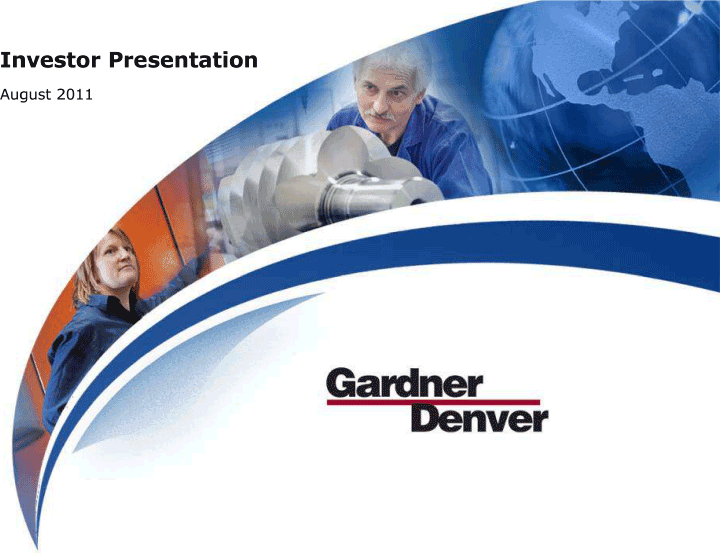
| Investor Presentation August 2011 |
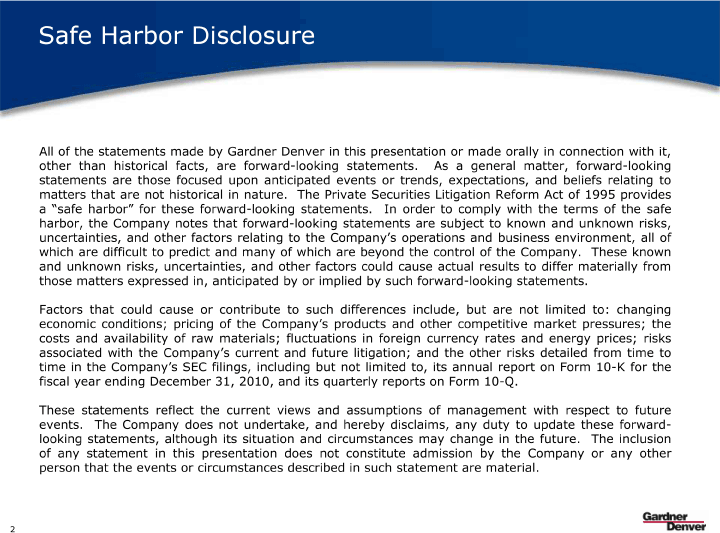
| 2 All of the statements made by Gardner Denver in this presentation or made orally in connection with it, other than historical facts, are forward-looking statements. As a general matter, forward-looking statements are those focused upon anticipated events or trends, expectations, and beliefs relating to matters that are not historical in nature. The Private Securities Litigation Reform Act of 1995 provides a “safe harbor” for these forward-looking statements. In order to comply with the terms of the safe harbor, the Company notes that forward-looking statements are subject to known and unknown risks, uncertainties, and other factors relating to the Company’s operations and business environment, all of which are difficult to predict and many of which are beyond the control of the Company. These known and unknown risks, uncertainties, and other factors could cause actual results to differ materially from those matters expressed in, anticipated by or implied by such forward-looking statements. Factors that could cause or contribute to such differences include, but are not limited to: changing economic conditions; pricing of the Company’s products and other competitive market pressures; the costs and availability of raw materials; fluctuations in foreign currency rates and energy prices; risks associated with the Company’s current and future litigation; and the other risks detailed from time to time in the Company’s SEC filings, including but not limited to, its annual report on Form 10-K for the fiscal year ending December 31, 2010, and its quarterly reports on Form 10-Q. These statements reflect the current views and assumptions of management with respect to future events. The Company does not undertake, and hereby disclaims, any duty to update these forwardlooking statements, although its situation and circumstances may change in the future. The inclusion of any statement in this presentation does not constitute admission by the Company or any other person that the events or circumstances described in such statement are material. Safe Harbor Disclosure |
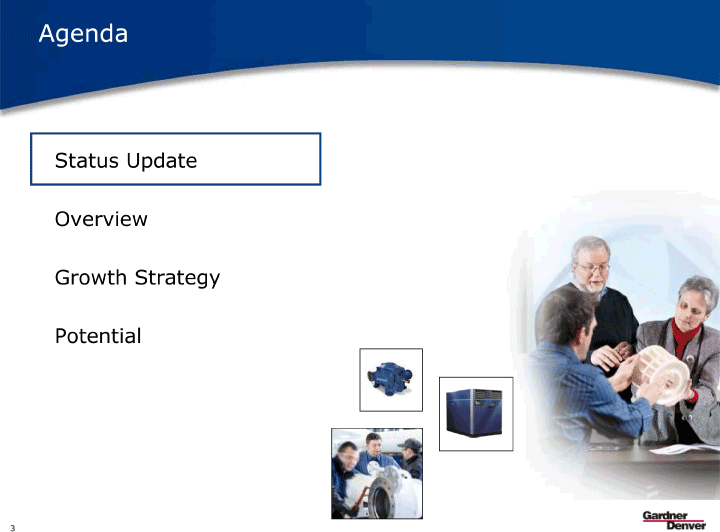
| 3 Agenda Status Update Overview Growth Strategy Potential |
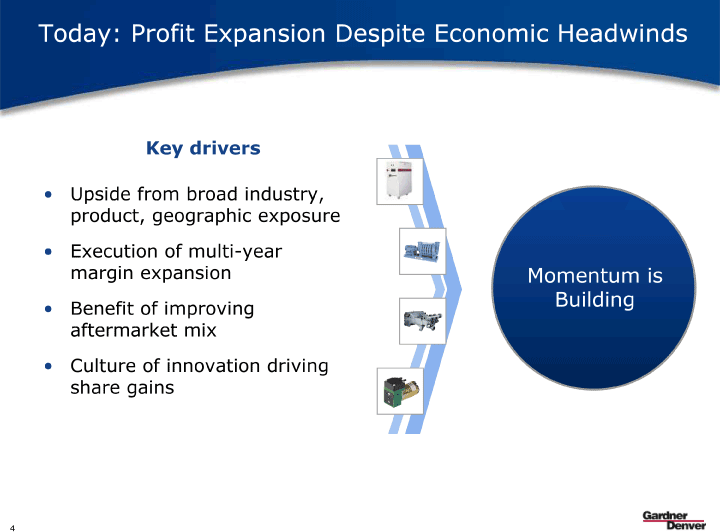
| 4 Today: Profit Expansion Despite Economic Headwinds • Upside from broad industry, product, geographic exposure • Execution of multi-year margin expansion • Benefit of improving aftermarket mix • Culture of innovation driving share gains Key drivers Momentum is Building |
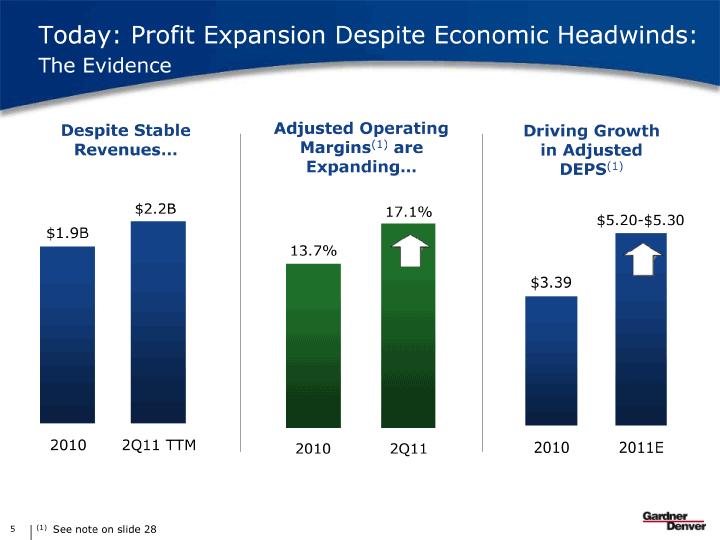
| 13.7% 17.1% 2010 2Q11 5 Today: Profit Expansion Despite Economic Headwinds: The Evidence $1.9B 2010 2Q11 TTM $3.39 2010 2011E Despite Stable Revenues... Adjusted Operating Margins(1) are Expanding... Driving Growth in Adjusted DEPS(1) (1) See note on slide 28 $5.20-$5.30 $2.2B |
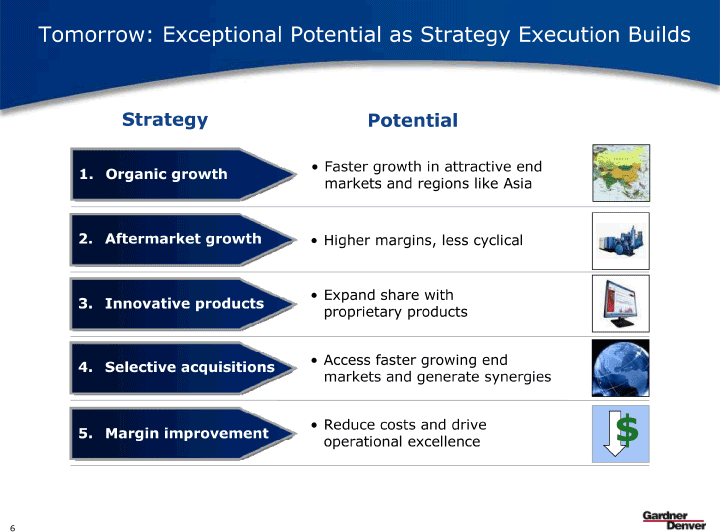
| 6 Tomorrow: Exceptional Potential as Strategy Execution Builds 1. Organic growth • Faster growth in attractive end markets and regions like Asia 4. Selective acquisitions • Access faster growing end markets and generate synergies Strategy Potential 2. Aftermarket growth • Higher margins, less cyclical 5. Margin improvement • Reduce costs and drive operational excellence $ 3. Innovative products • Expand share with proprietary products |
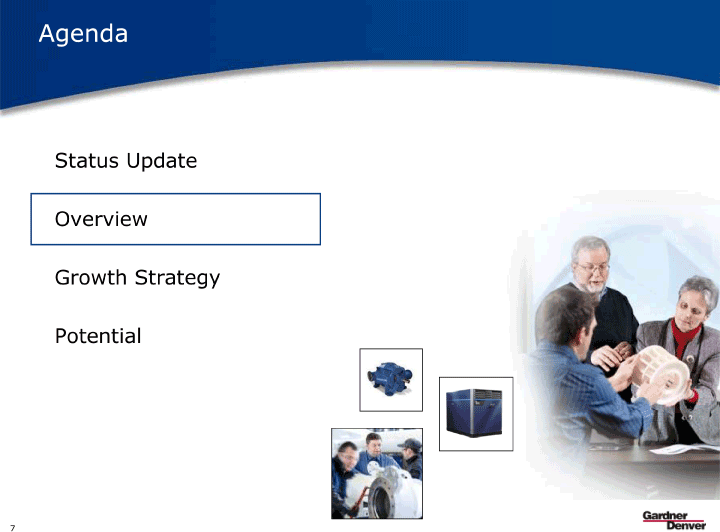
| 7 Agenda Status Update Overview Growth Strategy Potential |
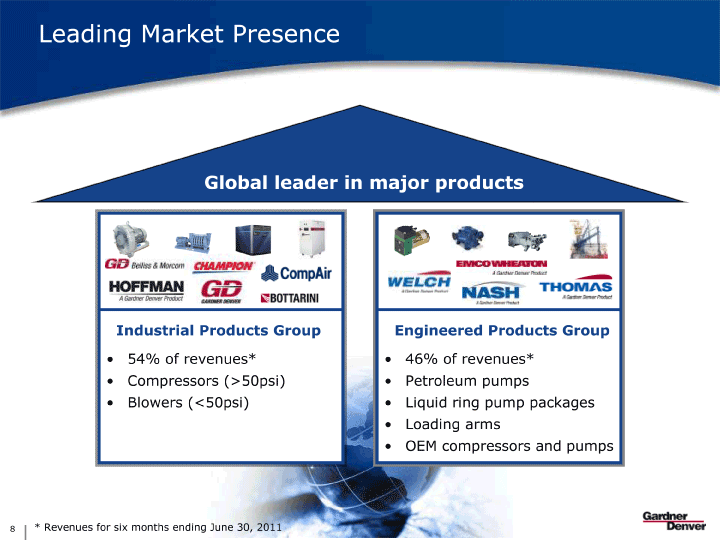
| 8 Leading Market Presence Global leader in major products Industrial Products Group • 54% of revenues* • Compressors (>50psi) • Blowers (<50psi) Engineered Products Group • 46% of revenues* • Petroleum pumps • Liquid ring pump packages • Loading arms • OEM compressors and pumps * Revenues for six months ending June 30, 2011 |
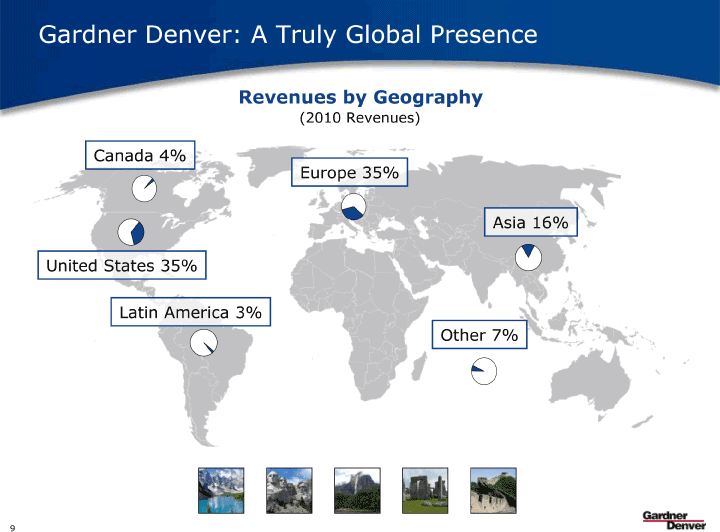
| 9 Gardner Denver: A Truly Global Presence Revenues by Geography Canada 4% United States 35% Latin America 3% Europe 35% Other 7% Asia 16% (2010 Revenues) |
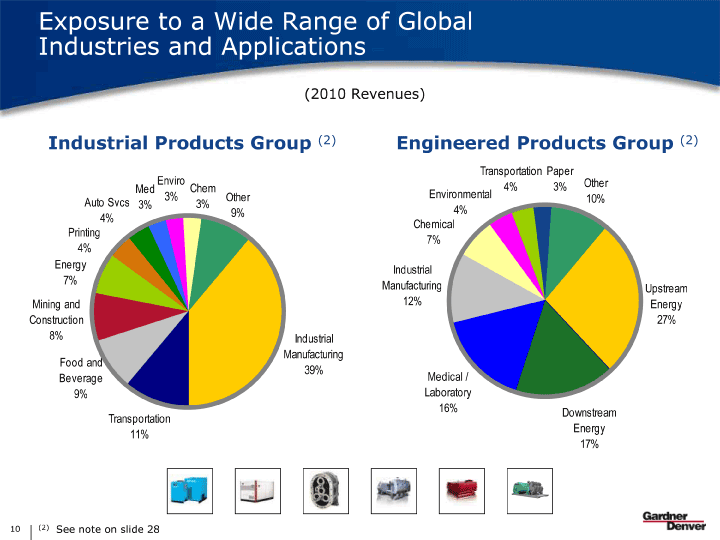
| 10 Exposure to a Wide Range of Global Industries and Applications Industrial Manufacturing 39% Food and Beverage 9% Auto Svcs 4% Printing 4% Med 3% Other 9% Chem 3% Enviro 3% Transportation 11% Mining and Construction 8% Energy 7% Industrial Products Group (2) Medical / Laboratory 16% Paper 3% Transportation 4% Other 10% Downstream Energy 17% Upstream Energy 27% Industrial Manufacturing 12% Environmental 4% Chemical 7% Engineered Products Group (2) (2010 Revenues) (2) See note on slide 28 |
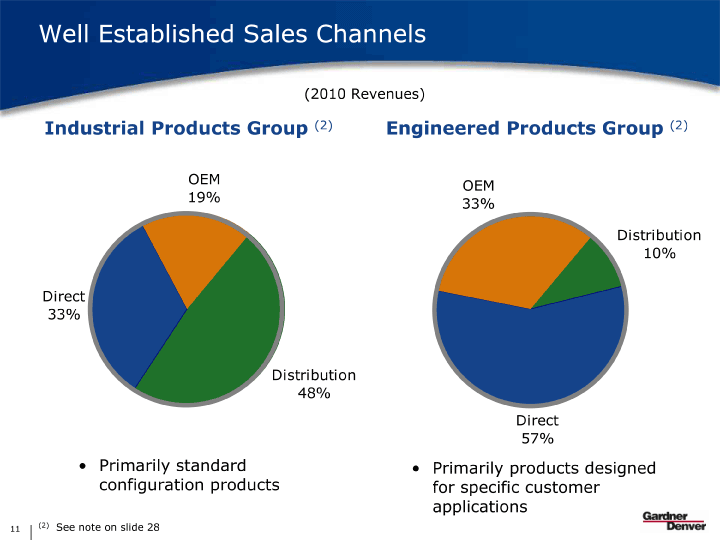
| 11 Well Established Sales Channels Distribution 48% Direct 33% OEM 19% Industrial Products Group (2) Distribution 10% Direct 57% OEM 33% Engineered Products Group (2) • Primarily standard configuration products • Primarily products designed for specific customer applications (2010 Revenues) (2) See note on slide 28 |
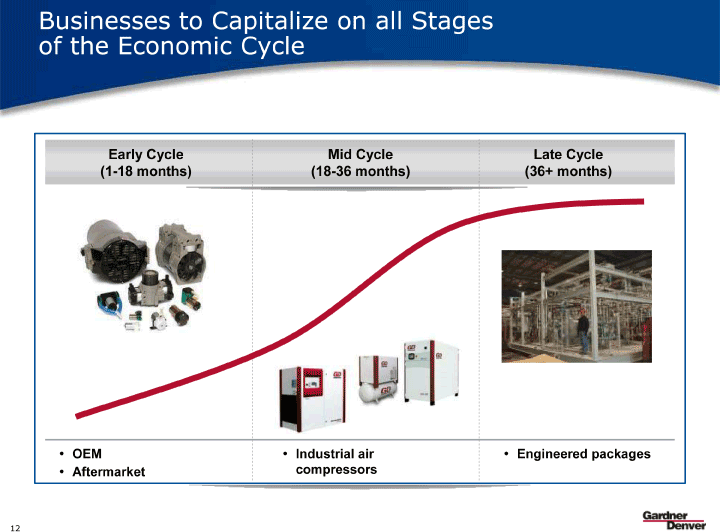
| 12 Businesses to Capitalize on all Stages of the Economic Cycle Early Cycle (1-18 months) Late Cycle (36+ months) Mid Cycle (18-36 months) _ Engineered package_ Industrial air s compressors _ OEM _ Aftermarket |
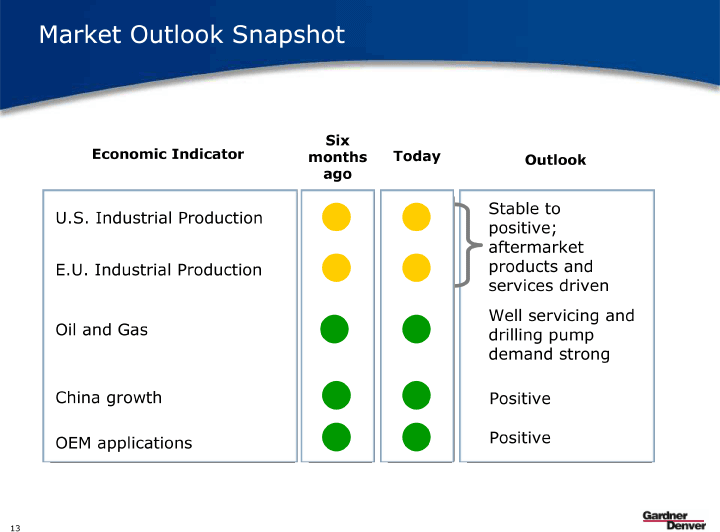
| Economic Indicator OutlooToday k Market Outlook Snapshot U.S. Industrial Production E.U. Industrial Production Oil and Gas China growth OEM applications Stable to positive; aftermarket products and services driven Well servicing and drilling pump demand strong Positive Positive Six months ago 13 |
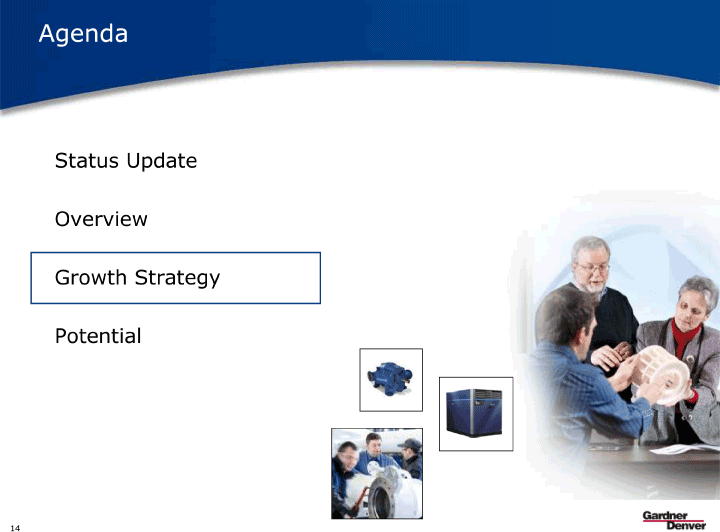
| 14 Agenda Status Update Overview Growth Strategy Potential |
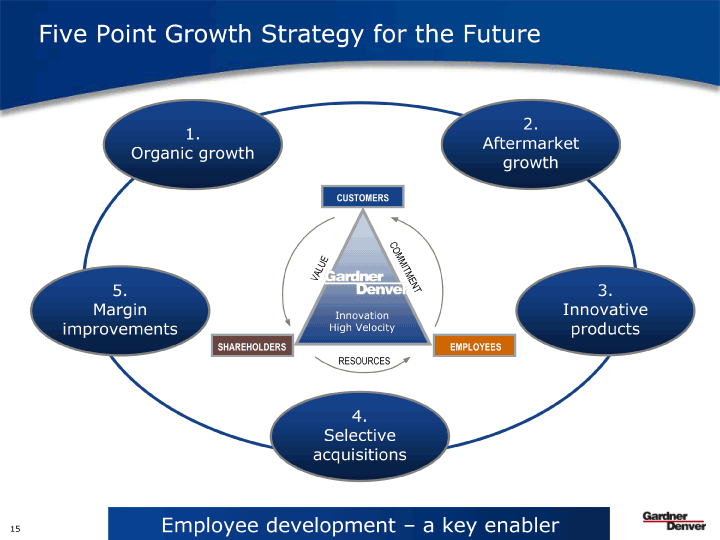
| 15 Five Point Growth Strategy for the Future 2. Aftermarket growth 3. Innovative products 4. Selective acquisitions 5. Margin improvements 1. Organic growth CUSTOMERS SHAREHOLDERS EMPLOYEES Innovation High Velocity VALUE COMMITMENT RESOURCES Employee development — a key enabler |
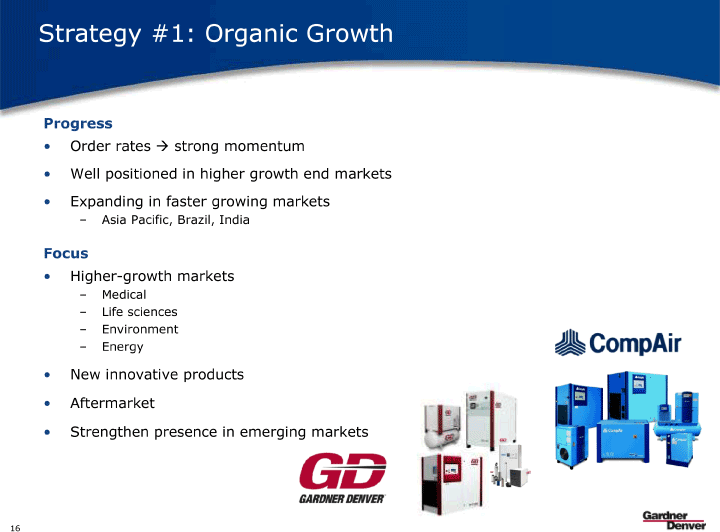
| 16 Strategy #1: Organic Growth Progress • Order rates _ strong momentum • Well positioned in higher growth end markets • Expanding in faster growing markets — Asia Pacific, Brazil, India Focus • Higher-growth markets — Medical — Life sciences — Environment — Energy • New innovative products • Aftermarket • Strengthen presence in emerging markets |
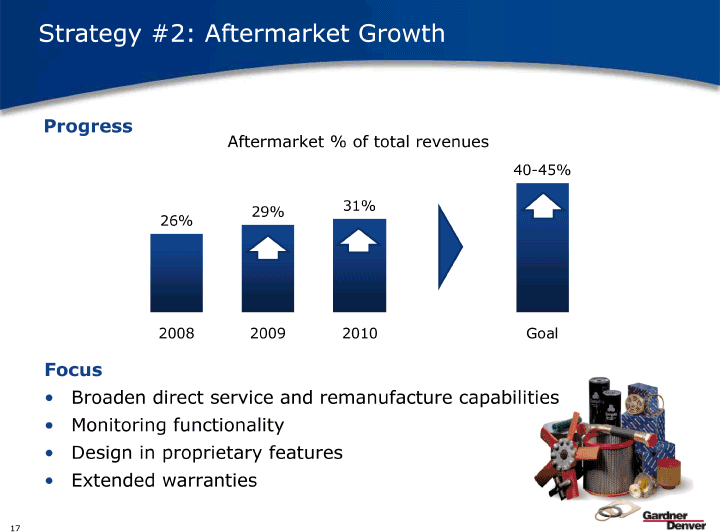
| 17 Strategy #2: Aftermarket Growth Progress Focus • Broaden direct service and remanufacture capabilities • Monitoring functionality • Design in proprietary features • Extended warranties 26% 29% 404-34%5% 31% 2008 2009 2010 Goal Aftermarket % of total revenues |
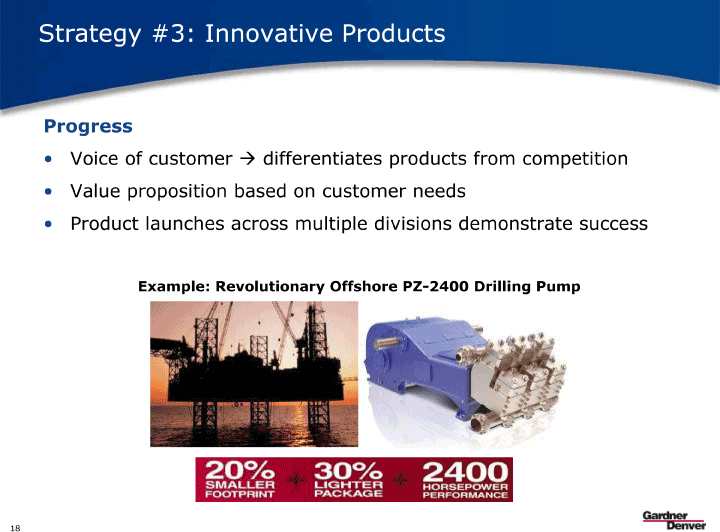
| 18 Strategy #3: Innovative Products Progress • Voice of customer _ differentiates products from competition • Value proposition based on customer needs • Product launches across multiple divisions demonstrate success Example: Revolutionary Offshore PZ-2400 Drilling Pump |
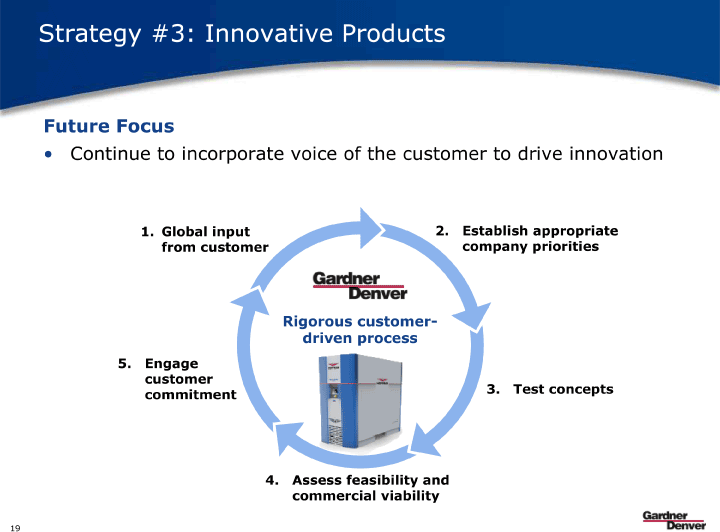
| 19 Strategy #3: Innovative Products Future Focus • Continue to incorporate voice of the customer to drive innovation 1. Global input from customer 2. Establish appropriate company priorities 3. Test concepts 4. Assess feasibility and commercial viability 5. Engage customer commitment Rigorous customerdriven process |
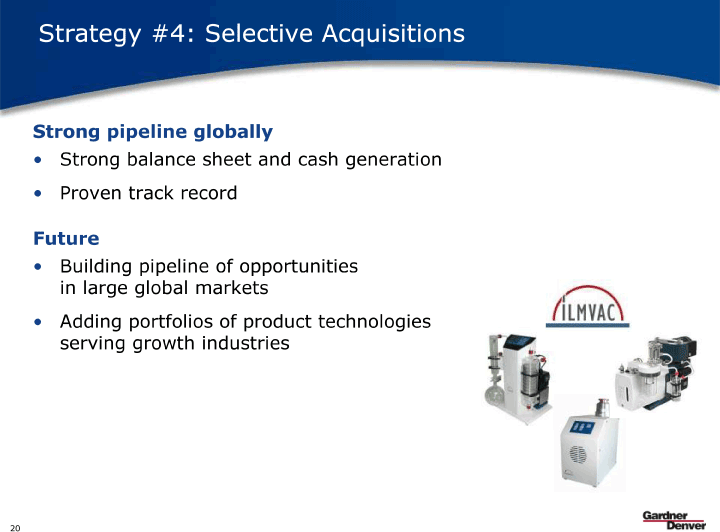
| 20 Strategy #4: Selective Acquisitions Strong pipeline globally • Strong balance sheet and cash generation • Proven track record Future • Building pipeline of opportunities in large global markets • Adding portfolios of product technologies serving growth industries |
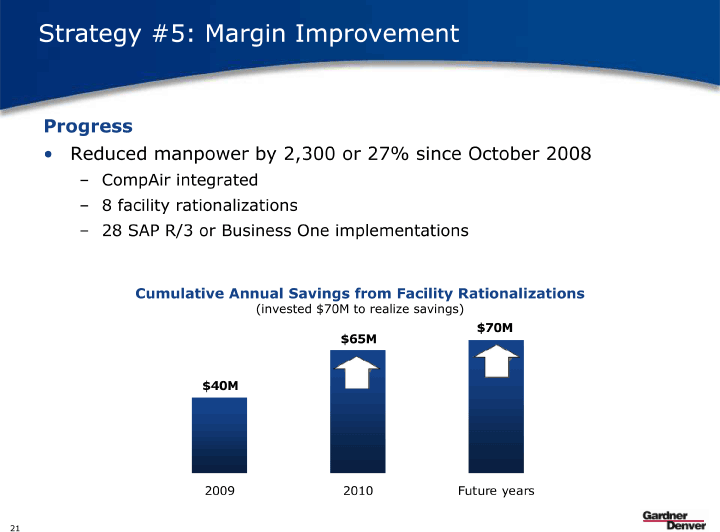
| 21 Strategy #5: Margin Improvement Progress • Reduced manpower by 2,300 or 27% since October 2008 — CompAir integrated — 8 facility rationalizations — 28 SAP R/3 or Business One implementations Cumulative Annual Savings from Facility Rationalizations (invested $70M to realize savings) $70M $65M $40M 2009 2010 Future years |
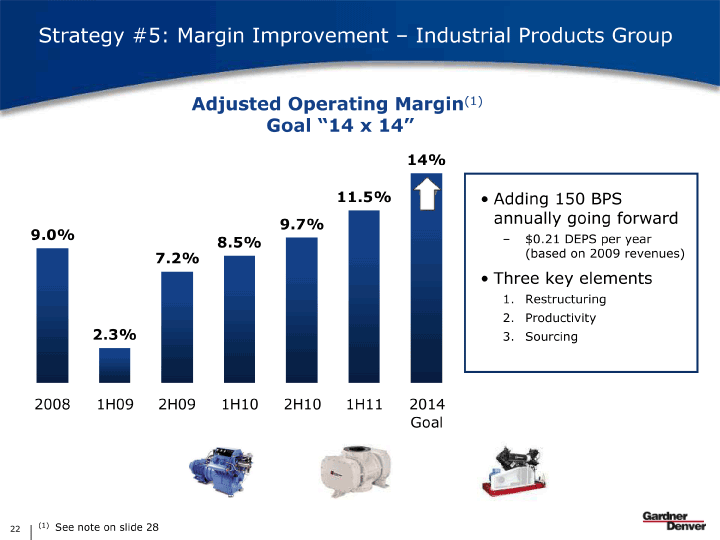
| 22 Strategy #5: Margin Improvement — Industrial Products Group Adjusted Operating Margin(1) Goal “14 x 14” 9.0% 2.3% 8.5% 9.7% 11.5% 14% 7.2% 2008 1H09 2H09 1H10 2H10 1H11 2014 Goal • Adding 150 BPS annually going forward — $0.21 DEPS per year (based on 2009 revenues) • Three key elements 1. Restructuring 2. Productivity 3. Sourcing (1) See note on slide 28 |
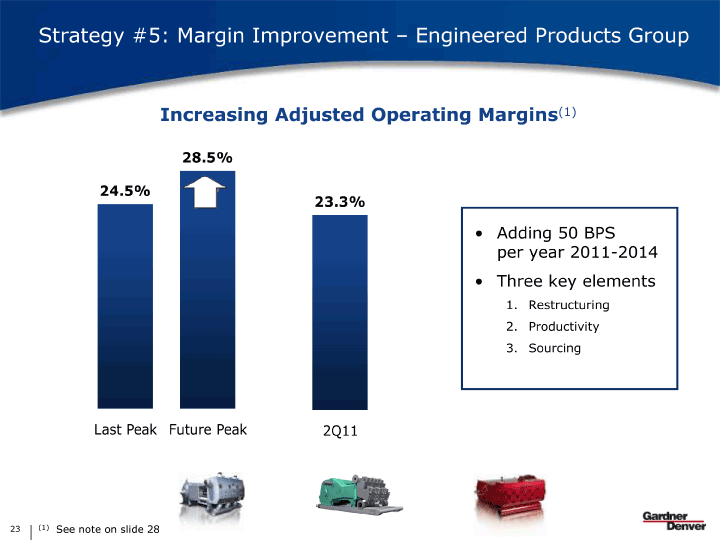
| 24.5% 28.5% Last Peak Future Peak 23 Strategy #5: Margin Improvement — Engineered Products Group Increasing Adjusted Operating Margins(1) (1) See note on slide 28 • Adding 50 BPS per year 2011-2014 • Three key elements 1. Restructuring 2. Productivity 3. Sourcing 23.3% 2Q11 |
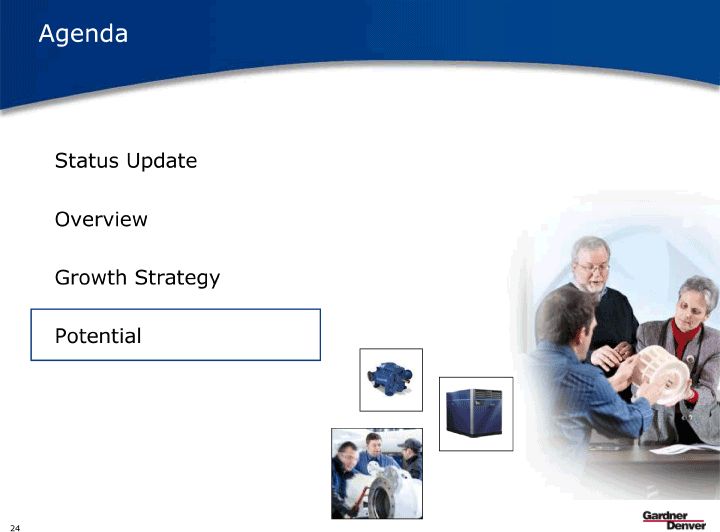
| 24 Agenda Status Update Overview Growth Strategy Potential |
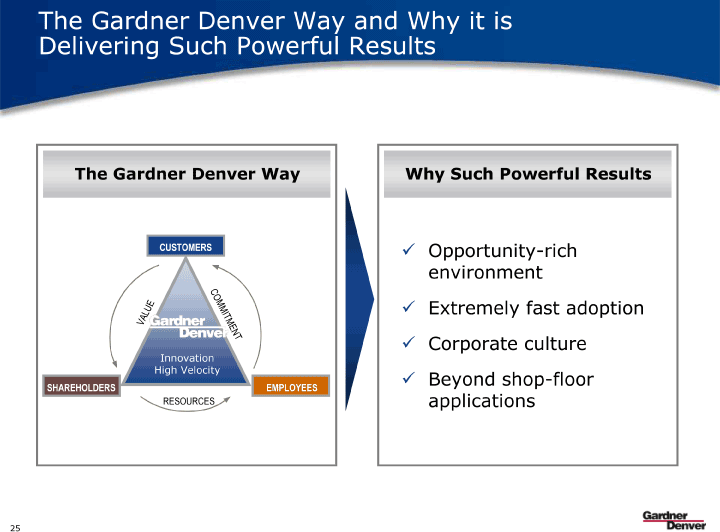
| 25 The Gardner Denver Way and Why it is Delivering Such Powerful Results Why Such Powerful Results CUSTOMERS SHAREHOLDERS EMPLOYEES Innovation High Velocity VALUE COMMITMENT RESOURCES The Gardner Denver Way _ Opportunity-rich environment _ Extremely fast adoption _ Corporate culture _ Beyond shop-floor applications |
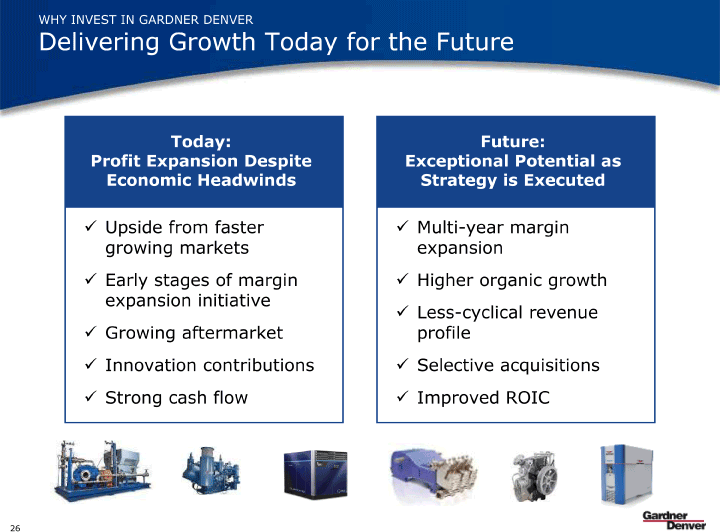
| 26 WHY INVEST IN GARDNER DENVER Delivering Growth Today for the Future Today: Profit Expansion Despite Economic Headwinds _ Upside from faster growing markets _ Early stages of margin expansion initiative _ Growing aftermarket _ Innovation contributions _ Strong cash flow Future: Exceptional Potential as Strategy is Executed _ Multi-year margin expansion _ Higher organic growth _ Less-cyclical revenue profile _ Selective acquisitions _ Improved ROIC |
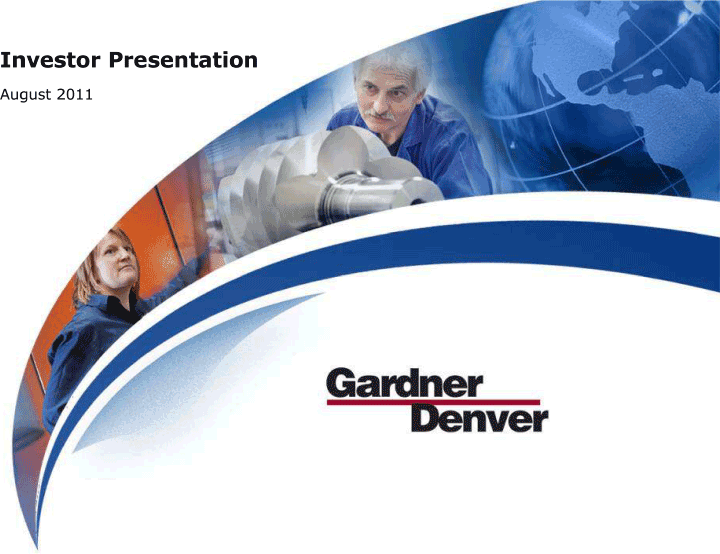
| Investor Presentation August 2011 |
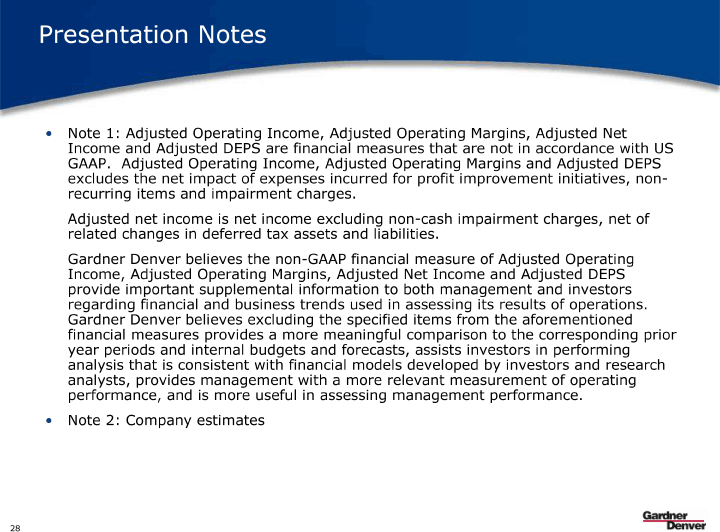
| Presentation Notes • Note 1: Adjusted Operating Income, Adjusted Operating Margins, Adjusted Net Income and Adjusted DEPS are financial measures that are not in accordance with US GAAP. Adjusted Operating Income, Adjusted Operating Margins and Adjusted DEPS excludes the net impact of expenses incurred for profit improvement initiatives, nonrecurring items and impairment charges. Adjusted net income is net income excluding non-cash impairment charges, net of related changes in deferred tax assets and liabilities. Gardner Denver believes the non-GAAP financial measure of Adjusted Operating Income, Adjusted Operating Margins, Adjusted Net Income and Adjusted DEPS provide important supplemental information to both management and investors regarding financial and business trends used in assessing its results of operations. Gardner Denver believes excluding the specified items from the aforementioned financial measures provides a more meaningful comparison to the corresponding prior year periods and internal budgets and forecasts, assists investors in performing analysis that is consistent with financial models developed by investors and research analysts, provides management with a more relevant measurement of operating performance, and is more useful in assessing management performance. • Note 2: Company estimates 28 |
